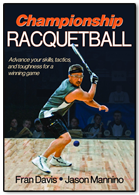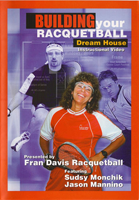 Question: “I’ve been watching videos and shadow rehearsing in a tiny office the back crossover vs the front crossover for covering shots. The videos go so fast, even in slow mo, that often I can’t tell if it’s a back or front crossover. In old school, with slow balls, there was only front crossover. I’m guessing that now it’s more back crossover and hitting shots off both wings in an open stance… Will u educate me?” – Bo Keeley
Question: “I’ve been watching videos and shadow rehearsing in a tiny office the back crossover vs the front crossover for covering shots. The videos go so fast, even in slow mo, that often I can’t tell if it’s a back or front crossover. In old school, with slow balls, there was only front crossover. I’m guessing that now it’s more back crossover and hitting shots off both wings in an open stance… Will u educate me?” – Bo Keeley
Cooperative Educational Offering on Modern Racquetball’s Movement Changes and New Directions
by Ken Woodfin
• Feet-work training, how novel – I hope there’s a change afoot. Although players may not yet focus on it specifically in drilling or as a point of emphasis in their technique enhancement – as they do their strokes and serves – players constantly move with more improvised, creative day to day footwork than even their coaches may realize or encourage. And hopefully drilling their feet-work is beginning to happen, in addition to time spent running ladders, working with resistance like bands and medicine balls, and ideally plyometrics training.
• Why change – Sure it’s the speed of game, the agility of players, and the crushing blow mentality. And it’s also the whatever is available effort to shorten the rally or make a get that calls upon all of the resources at the player’s disposal to respond in real-time, in the mere blink of an eye.
• More front or back crossovers and open stance hitting? To your point..,
Whether players back crossover more than front crossover and whether they open stance stroke more in the modern game is a living example of innovation being the very mother of invention. The back or *behind* or accurately retreating crossover and crisscross (cross step behind with trail foot) would both logically be the extension of the premise that the game is fast, hitting on the run is a given, and hitting off the back foot by just stepping over and lunging back with the trail foot is just bad, inefficient form. Using a hastily established open stance off a diagonal drop either at the end of (a) the behind crossover and then lunge with the posting foot, or (b) the behind crisscross and then lunge would both seem to be better than just a long, desperate lunge with the closest leg and a squash-like reach to flick or maybe a worse case layout into a full out dive and whack to the back-wall.
• After crossover best case
If time allows, either the back cross or back crisscross may be followed up with the feet-work move to get behind and beside the ball to then drive back into the ball with the stroking stance the player does best. That’s Plan A to step in and stroke. Plan B is the Open stance.
• Plan A Stroke to fool um
In Plan A, an advanced stance should be a deceptive one that disguises the shot or leaves the cover player to guess at the intended target. Pointing with your feet or even locating the ball in your stance would both raise a warning flag to the alert cover allowing her or him to recognize and cover that shot or angle and thus augment their anticipation, revealing their coverage run plan right-as-you-stroke forward or right after they see your racquet butt commit to move forward. The partially closed stance is both deceptive and ergonomically sound. Half a tennis shoe closer to the sidewall opens up all angles and allows for knee drive, hip pop, and upper body triangle flow (triangle = formed by shoulders and waist).
• Full lateral move risk
Slight desperation may elicit a direct lateral crossover to gain space fast, but odds are against the cover player having much offensive success because of multiple challenges of poor visual perception of a ball being intercepted as it hurtles by in front of your face, prep time is squeezed down, and the wall is both a physical and mental barrier.
• Plan A and the “L” to stroke
In less pressured moments, players do execute little *”L” shaped maneuvers and the front crossover finalizes their stroke stance.
*Consider this: the “L” is backwards on the floor at your feet. *_|*. The back foot steps on the bottom of the “L” closest to you and front foot steps up to the top of the “L”.
• Plan D emergency turned into routine put-away
In exigent circumstances players also use the front cross to lunge diagonally forward for gets. Or, like the Kane bump, it’s used to lunge and flick a put-away into a low target. An example is Kane’s routinely selected corner pinch put-away.
• What’s best, crisscross or crossover forward? It depends…
In my postage stamp floorspace, from a standstill start about two steps behind the ball, the crisscross forward seems to provide the *banana stem in* I enjoy for its increased inwards pulling force. I choose it over the crossover forward, which appears to send my weight laterally away from my center. So that’s perhaps why it seems more instinctively and intuitively attractive to me to use and endorse the behind crisscross. However, over the long haul, the forward crossover is a major space gobbler. For a long dash forward, I’d suggest the forward crossover anytime as the igniter for your run. The forward crossover is especially effective from a balanced, more upright cover position than say at the end of a low, knees scraping the floor stroke where a push off to regain balance is step one. To recover from a low body angle stroke, a crisscross might get you going best because it can be incorporated into the rebalancing move. Study this and let me know.
• Plan B, the Open stance
The open stance is such an integral part of the game why it’s practiced or emphasized so little just amazes me. Forms of it are used a substantial percentage of the time in rallies and ROS situations. Although granted tennis players do use it also as an aid to clear the net, with its upwards momentum ingredient, they also do it to add disguise, spin, and of course body rotationally generated force. They leave the ground to swing up and over, but they also do it to take the torque off their legs, hips, back and shoulders. I think that’s the next step in elevating the movement of players, jumping and shooting, even from the back court in what used to be ceiling ball rallies or in bang-bang mid court rallies to attack belly to eye high balls with leaping swing volley, high-to-low strokes.
I hope I answered your question and raised a few more. It’d be a blast to study tape with you.
• Plan C plyometrics, and in case you forget…
The only way to get there in Feet-work is to train, and pylometrically speaking. It is “jump training”, or “pylos” exercises based around having muscles exert maximum force in as short a time as possible. The goal is to increase speed and power. The focus is leg movement as to move from a muscle extension to a contraction in a rapid or “explosive” way, as with repeated jumping. Plyometrics are used by high jumpers and discus throwers to improve performance, and to a lesser degree in the fitness field. The explosive bursts define racquetball with all forms of jumps in the shortest execution time. Jump training gets you there quicker than you used to.
And there may all you killshots be rollouts, except, of course, when you play me, Ken Woodfin, Author of “Feet-work”
International Racquetball Tour. IRT.










